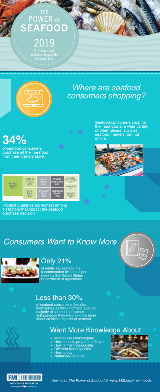 The ocean floor stretches miles below the sea’s surface, leaving a world of mystery to the human eye. In a similar way, the seafood category is distinct, intriguing and not as visible as others.
The ocean floor stretches miles below the sea’s surface, leaving a world of mystery to the human eye. In a similar way, the seafood category is distinct, intriguing and not as visible as others.
What reveals the market potential for seafood at retail, given the diversity of products and varying availability and seasonality around the country? The Power of Seafood report – the first in FMI’s “Power of…” series to focus on seafood – shares that one underlying characteristic of seafood shoppers is their discerning nature.
Discerning doesn’t mean picky. Discerning means that seafood shoppers are selective in what, why, where and how they buy seafood to take home and cook or eat.
One significant finding from The Power of Seafood is that although the seafood sector is comparatively smaller than fresh meat and poultry it is lucrative. For example, 44 percent of adults are not even occasional seafood consumers and the average per capita consumption of seafood is 16 pounds. Seafood shoppers have a higher average household income and education level and choose to spend more money on groceries, and when these shoppers buy seafood, the average basket size nearly triples versus non-seafood consumers.
Seafood shoppers put less emphasis on price than quality. In fact, product quality is the leading factor in the seafood purchasing decision, according to The Power of Seafood. Following quality, consumers look for freshness, taste/flavor and species.
According to The Power of Seafood, shoppers are also discerning in where they buy their seafood. Most shop for seafood at their primary grocery store, but 31 percent say they shop for seafood elsewhere. In addition, only 34 percent of seafood consumers purchase all their seafood from their primary store for seafood. Other places seafood consumers shop for their seafood include other supermarkets, seafood stores, farmers markets, seafood markets/stands, or natural/organic stores.
Their selective taste and high expectations extend to shoppers’ attitudes toward the benefits of eating seafood. The Power of Seafood confirms that seafood consumers are more likely than their non-seafood-eating counterparts to put effort into choosing healthy, nutritious items.
Peeling back the shell, to borrow a relevant term, today’s seafood shoppers are discerning in what they buy, too. Longtime favorites like shrimp, salmon and tuna are still king, representing a combined 60 percent of the market. That said, seafood counters and freezers, along with prepared food areas and delis, can carry more types of fin fish, mollusks and crustaceans. Retailers might consider touting (and sampling) other options like flounder, trout, haddock, crawfish, halibut, herring, swordfish, mussels, snapper, mahi mahi, sole, sea bass and grouper, to name a few. They also can tap into the potential for replicating restaurant experiences, since more than half of seafood consumers have tried making a seafood dish at home that they enjoyed when dining out.
For all new and potential trials, education and shopper outreach is important. The Power of Seafood report reveals that less than 30 percent of seafood consumers say they are very knowledgeable about seafood. That means a whopping 70 percent of customers are fishing (excuse the pun) for more information, and many non-seafood shoppers say they want to know more about it. For every discerning seafood shopper willing to spend, there can be another occasional or new buyer just beneath the surface.
Download The Power of Seafood here.


 Industry Topics address your specific area of expertise with resources, reports, events and more.
Industry Topics address your specific area of expertise with resources, reports, events and more.
 Our Research covers consumer behavior and retail operation benchmarks so you can make informed business decisions.
Our Research covers consumer behavior and retail operation benchmarks so you can make informed business decisions.
 Events and Education including online and in-person help you advance your food retail career.
Events and Education including online and in-person help you advance your food retail career.
 Food Safety training, resources and guidance that help you create a company food safety culture.
Food Safety training, resources and guidance that help you create a company food safety culture.
 Government Affairs work — federal and state — on the latest food industry policy, regulatory and legislative issues.
Government Affairs work — federal and state — on the latest food industry policy, regulatory and legislative issues.
 Get Involved. From industry awards to newsletters and committees, these resources help you take advantage of your membership.
Get Involved. From industry awards to newsletters and committees, these resources help you take advantage of your membership.
 Best practices, guidance documents, infographics, signage and more for the food industry on the COVID-19 pandemic.
Best practices, guidance documents, infographics, signage and more for the food industry on the COVID-19 pandemic.
